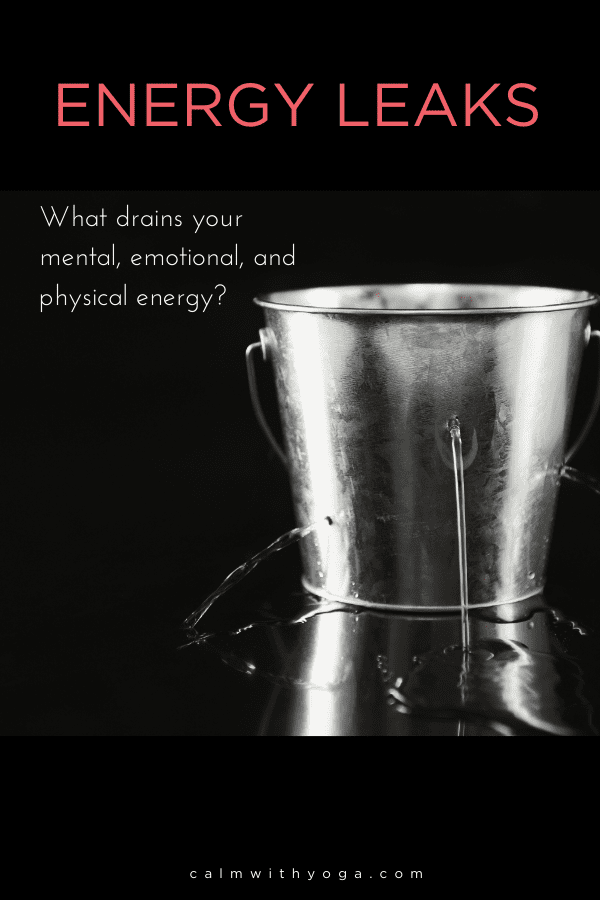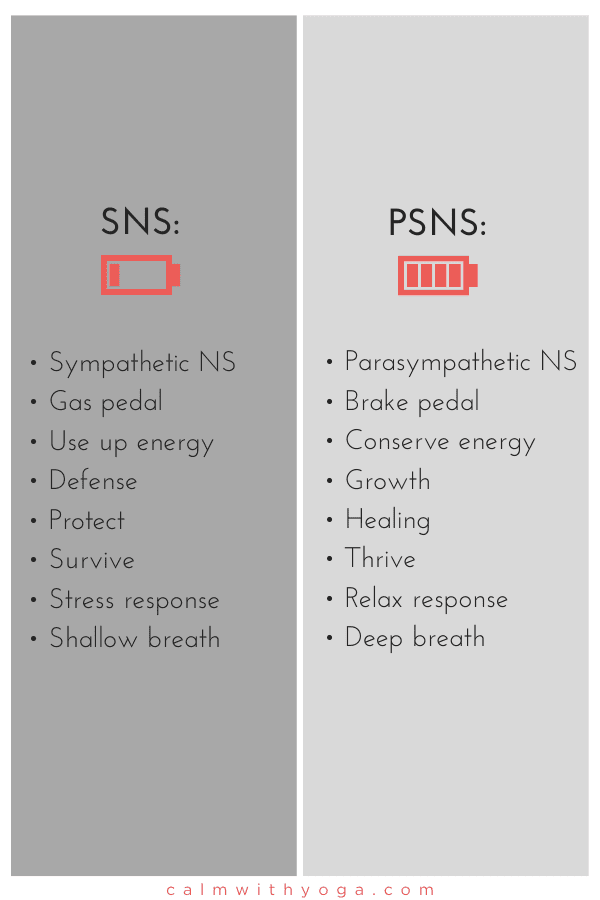The more efficient your body, the better you feel and the more you will use your talent to produce outstanding results. Tony Robbins, author, entrepreneur, philanthropist Most of us want to reach our goals, tackle our to-do’s, show up for the people we love, create inspired work output, and somehow enjoy life’s little moments along the way. So how are we supposed to achieve all of this if we’re running on fumes at the end of each day? Another cup of coffee is not always the best answer.
It turns out that something as simple and overlooked as your own breath is a proven powerful tool for naturally boosting your energy levels in a sustainable way.
Pranayama (yoga breathing practices) can provide your bodily system with an instant reboot and reset. Using breathwork as a meditation practice helps to increase well-being and empowering emotional states. Here’s how…
Plugging Energy Leaks + Building Energy Reserves
Feeling drained or ‘running on fumes’ is an indication of two things: 1 – that we have holes in our vital energy bucket, and these leaks are depleting our reserves 2- that we aren’t efficiently building energy reserves fast enough, because we’re expending more energy than we’re replenishing. The nervous system (NS) is one of the main mechanisms at play when it comes to energy management. Our bodies are wired with two branches of the autonomic nervous system: the sympathetic nervous system (SNS) and the parasympathetic nervous system (PSNS.) Think of them like this:
The SNS is the branch that is responsible for mobilizing energy reserves during real or perceived stressful/ challenging/ demanding situations. (aka stress response, fight-flight-freeze response) The SNS acts much like a gas pedal, expending energy when it is activated. The PSNS is the branch that oversees energy conservation during periods of rest, safety, and connection. (aka relaxation response, rest-and-digest response) The PSNS is the brake pedal that helps us slow down so we can plug leaks, minimize drain, and refuel or replenish reserves. If we don’t change the way our body responds to challenging and demanding situations, we’ll keep activating the gas pedal more and more while activating the brake pedal less and less. We can balance these two systems out and therefore balance our energy out by mindfully and intentionally activating our breath.
The thing these two branches have in common is the breath, which acts like a switching station between the two.
Nadi Shodhana, aka Alternate Nostril Breathing (ANB): A Science-Backed Yogic Hack
You’re about to learn a powerful, yet very simple yogic breathing exercise that has been proven to help balance out disparities between the two autonomic nervous system branches. The brain and spinal cord can be seen as the generating station. The nerves and nadis carry the electricity throughout the body. If there is a good flow of electricity (i.e., energy or prana) and if the wires conducting the electricity are all strong, sturdy, and in good shape, everything runs well. But if there is no adequate flow of energy or if the wires leading from the generator are damaged or there are loose connections, then the power system does not function optimally. Through yoga practice, particularly pranayama, the nadis and nerve centers are purified and stimulated, and the energy is channeled to optimal output and functioning. – Swami Satchidananda, The Breath of Life: Integral Yoga Pranayama
By adopting a consistent and regular practice with just this one technique, you can begin to manage your energy better and aid your body in responding more efficiently to stressful situations.
This technique works so well that even Hillary Clinton used it to help her manage her energy during and after the most recent elections. (1) ANB is also called Nadi Shodhana Pranayama. (‘subtle energy clearing breathing technique’ ) In Sanskrit ‘nadi’ means ‘channel’ and ‘shodhana’ means ‘purifying.’ Therefore, this technique cleanses and purifies the nadis – the channels through which vital energy (prana) flows. It involves alternating exhales and inhales between nostrils… switching between the left side and right side. We breathe out and in through one nostril, while the other nostril is closed and vice versa, repeating the sequence. This switching between nostrils is thought to impact the nasal cycle, which is linked to activity in the brain. The nasal cycle refers to the congestion/decongestion pattern of the nasal cavities. Nostril opening switches between nostrils on average every 1.5 – 4 hours. (2) The openness of the nostril is connected to activity in the opposite hemisphere of the brain. For whichever nostril is more open, the opposite side of the brain is more active. (3)
5 science-backed benefits of alternate nostril breathing:
1- ANB helps to balance your nervous system Breathing alternatively through each nostril has been shown to help restore balance to your autonomic nervous system. (4) This means that every time you practice ANB you’re helping to plug the energy leaks in your bucket. You’ll generate more energy and less fatigue while also increasing your resilience to effectively face the stresses and challenges of everyday life. 2 – ANB activates your PSNS, which increases the calming/ relaxation/ regenerative response in the body. (5) This means that every time you practice ANB you’re not just plugging leaks, you’re also replenishing reserves. 3 – As mentioned, ANB appears to have a balancing effect on the activity of the hemispheres of the brain. (6) 4 – ANB has been shown to reduce high blood pressure while possibly improving performance and concentration. (7) 5- It may improve respiratory and circulatory function. (8)
How to practice alternate nostril breathing:
Place your left hand on the left knee, palm open to the sky. Use the thumb, middle finger, and ring finger on the right hand to alternately block off the nostrils as we breathe out and in. The thumb on your right hand blocks the right nostril as you breathe out, and in. The ring and middle fingers block the left nostril as you breathe out and in. Now rotate your hand so you are ready to use the thumb to close the right nostril and the middle and ring finger to close the left nostril, holding your hand, near your face. Breathe in. Use the right thumb to block the right nostril and breathe out. Keep the thumb where it is and breathe in. Now switch to blocking the left nostril with the fingers and breathe out. Keep the fingers where they are and breathe in. Release your nostrils and breathe normally. You have now completed one round of Nadi Shodhana/ Alternate nostril pranayama. You’re doing amazing things for your body and mind by using this pranayama practice at least 5 minutes a day. Consistency matters and each session builds upon the next. Show up for your practice and your practice will reward you with the full range of benefits. REFERENCES : (1) https://www.washingtonpost.com/news/inspired-life/wp/2017/09/15/hillary-clinton-used-alternate-nostril-breathing-after-her-election-loss-heres-why-you-really-should-too/?noredirect=on&utm_term=.e89d63db7edf (2) https://www.ncbi.nlm.nih.gov/pmc/articles/PMC5053491/ (3) http://europepmc.org/abstract/med/6874437 (4) http://www.msjonline.org/index.php/ijrms/article/view/3581 (5) https://www.ncbi.nlm.nih.gov/pmc/articles/PMC3681046/ (6) http://www.sciencedirect.com/science/article/pii/0167876084900175 (7) https://www.ncbi.nlm.nih.gov/pmc/articles/PMC3628802/ (8) https://www.researchgate.net/publication/23168383_Effect_of_alternate_nostril_breathing_exercise_on_cardiorespiratory_functions




title: “Alternate Nostril Breathing Increases Vital Energy Motherhood Community” ShowToc: true date: “2023-01-03” author: “Sandra Medcalf”
Tony Robbins, autor, empresario, filántropo La mayoría de nosotras experimentamos grandes y pequeños desafíos y demandas diariamente. Necesitamos toda la energía que podamos obtener para cumplir no solo con esas demandas, sino también para prosperar más allá de ellas. La mayoría de nosotras buscamos alcanzar nuestras metas, enfrentarnos a las tareas pendientes, estar presentes para las personas que amamos, crear resultados de trabajo inspiradores y, de alguna manera, disfrutar los pequeños momentos de la vida en el camino. Entonces, ¿cómo se supone que debemos lograr todo esto cuando nos estamos quedando sin gas al final de cada día? Otra taza de café no es siempre la mejor respuesta.
Sorprendentemente, resulta que algo tan simple y pasado por alto como tu propia respiración es una herramienta poderosa y probada para aumentar naturalmente tus niveles de energía de una manera sostenible.
La tecnología de respiración yóguica o Pranayama puede proporcionar a tu sistema corporal un inicio y reinicio instantáneos. Aquí tienes cómo…
Tapando las Fugas de Energía + Creando Reservas de Energía
Sentirte drenada o ‘quedarte sin gas’ es una indicación de dos cosas: 1 – que tenemos agujeros en nuestro cubo de energía vital, y estas fugas están agotando nuestras reservas 2- que no estamos construyendo las reservas de energía de manera eficiente lo suficientemente rápido, porque estamos gastando más energía de la que estamos reponiendo. El sistema nervioso (SN) es uno de los principales mecanismos en juego cuando se trata de la gestión de la energía. Nuestros cuerpos están conectados con dos ramas del sistema nervioso autónomo: el sistema nervioso simpático (SNS) y el sistema nervioso parasimpático (SNPS). Piénsalos así:
El SNS es la rama responsable de movilizar las reservas de energía en situaciones reales o percibidas de estrés/desafío/exigencia. (también conocido como respuesta al estrés, respuesta de lucha-huida-parálisis) El SNS actúa como un pedal del acelerador, gastando energía cuando se activa. El SNPS es la rama que supervisa la conservación de energía durante los períodos de descanso, seguridad y conexión. (también conocida como respuesta de relajación, respuesta de reposo y digestión) El SNPS es el pedal de freno que nos ayuda a reducir la velocidad para que podamos tapar las fugas, minimizar el drenaje y reabastecer o reabastecer las reservas. Si no cambiamos la forma en que nuestro cuerpo responde a las situaciones difíciles y exigentes, seguiremos activando el pedal del acelerador cada vez más mientras activamos el pedal del freno cada vez menos. Podemos equilibrar estos dos sistemas y, por lo tanto, equilibrar nuestra energía mediante la activación consciente e intencional de nuestra respiración.
Lo que estas dos ramas tienen en común es la respiración, que actúa como una estación de conmutación entre las dos.
Nadi Shodhana, también conocida como respiración de las fosas alternadas (Alternate Nostril Breathing, ANB, por sus siglas en inglés): Un Truco Yóguico Respaldado Por La Ciencia
Estás a punto de aprender un ejercicio de respiración yóguica potente, pero muy simple, que ha demostrado ayudar a equilibrar las disparidades entre las dos ramas del sistema nervioso autónomo. El cerebro y la médula espinal se pueden ver como la estación generadora. Los nervios y nadis llevan la electricidad a todo el cuerpo. Si hay un buen flujo de electricidad (es decir, energía o prana) y si los cables que conducen la electricidad son fuertes, resistentes y están en buena forma, todo funciona bien. Pero, si no hay un flujo adecuado de energía o si los cables que salen del generador están dañados o hay conexiones sueltas, entonces el sistema de energía no funciona de manera óptima. A través de la práctica del yoga, particularmente el pranayama, los nadis y los centros nerviosos se purifican y estimulan, y la energía se canaliza hacia la producción y el funcionamiento óptimos. – Swami Satchidananda, The Breath of Life: Integral Yoga Pranayama
Al adoptar una práctica consistente y regular con solo esta técnica, puedes comenzar a administrar mejor tu energía y ayudar a tu cuerpo a responder de manera más eficiente ante situaciones estresantes.
Esta técnica funciona tan bien que incluso Hillary Clinton la usó para ayudarse a administrar su energía durante y después de las elecciones más recientes. (1) ANB también se llama Nadi Shodhana Pranayama. (‘técnica de respiración de limpieza de energía sutil’) En sánscrito ‘nadi’ significa ‘canal’ y ‘shodhana’ significa ‘purificación’. Por lo tanto, esta técnica limpia y purifica los nadis, los canales a través de los cuales fluye el prana. Implica alternar exhalaciones e inhalaciones entre las fosas nasales. Exhalamos e inhalamos por una fosa nasal, mientras que la otra está cerrada, y viceversa repitiendo la secuencia. Se piensa que este cambio entre las fosas nasales afecta el ciclo nasal, que está vinculado a la actividad en el cerebro. El ciclo nasal se refiere al patrón de congestión/descongestión de las cavidades nasales. La apertura de las fosas nasales cambia entre las fosas nasales derecha e izquierda en promedio cada 1,5 a 4 horas. (2) La apertura de la fosa nasal está conectada a la actividad en el hemisferio opuesto del cerebro. Cualquiera sea la fosa nasal que esté más abierta, significa que el lado opuesto del cerebro es más activo. (3) Los hemisferios del cerebro se verán afectados directamente por la respiración alternada. Cuando alguien inhala y exhala con ejercicios de flujo suave concentrándose en los canales de energía, logra mejorar el momento presente y prepararse para un mejor futuro. Sin embargo, todo se trata de técnica. Por ejemplo, a través de la fosa nasal derecha, no trabajarás el lado derecho del cerebro, sino el izquierdo. Así mismo, cuando uses la fosa izquierda, no estarás trabajando sobre el lado izquierdo de tu cerebro, sino tu lado derecho. Estos ejercicios deben realizarse con los ojos cerrados, inhalando y exhalando siempre por la misma fosa, usando el dedo pulgar derecho o izquierdo, y haciéndolo con calma. Haciendo estos ejercicios de relajación y respiración alternada, verás que tu sistema nervioso se va calmando. La respiración de fosas alternadas es una técnica de respiración única y totalmente eficaz comprobada. Lo único que debes incluir en este ejercicio son pocas partes de tu cuerpo, tu mano izquierda y tu mano derecha, dedo meñique, dedo anular y, por supuesto, las fosas nasales.
Aquí hay 5 beneficios de la técnica de respiración de las fosas nasales alternas respaldados por la ciencia:
1- ANB ayuda a equilibrar tu sistema nervioso. Se ha demostrado que respirar alternativamente a través de cada fosa nasal ayuda a restablecer el equilibrio en tu sistema nervioso autónomo. (4) Esto significa que cada vez que practicas ANB estás ayudando a tapar las fugas de energía en tu cubo. Generarás más energía y menos fatiga, al mismo tiempo que aumentará tu capacidad de recuperación para enfrentar eficazmente las tensiones y los desafíos de la vida cotidiana. 2 – ANB activa tu SNPS, lo que aumenta la respuesta de calma/relajación/regeneración en el cuerpo. (5) Esto significa que, cada vez que practicas ANB, no solo estás tapando las fugas, también estás llenando las reservas. 3 – Tal como se mencionó, la ANB parece tener un efecto de equilibrio sobre la actividad funcional de los hemisferios cerebrales izquierdo y derecho. (6) 4 – Se ha demostrado que la ANB reduce la presión arterial alta y posiblemente mejora el rendimiento y la concentración. (7) 5- Puede mejorar la función respiratoria y circulatoria. (8) Y ahora, saltemos directamente a una sesión de meditación de pranayama: Déjame saber cómo te va con esta práctica. Se ha demostrado que incluso diez minutos al día de esta técnica realmente puede ayudar a aumentar tus niveles de energía. (1) https://www.washingtonpost.com/news/inspired-life/wp/2017/09/15/hillary-clinton-used-alternate-nostril-breathing-after-her-election-loss-heres-why-you-really-should-too/?noredirect=on&utm_term=.e89d63db7edf (2) https://www.ncbi.nlm.nih.gov/pmc/articles/PMC5053491/ (3) http://europepmc.org/abstract/med/6874437 (4) http://www.msjonline.org/index.php/ijrms/article/view/3581 (5) https://www.ncbi.nlm.nih.gov/pmc/articles/PMC3681046/ (6) http://www.sciencedirect.com/science/article/pii/0167876084900175 (7) https://www.ncbi.nlm.nih.gov/pmc/articles/PMC3628802/ (8) https://www.researchgate.net/publication/23168383_Effect_of_alternate_nostril_breathing_exercise_on_cardiorespiratory_functions



